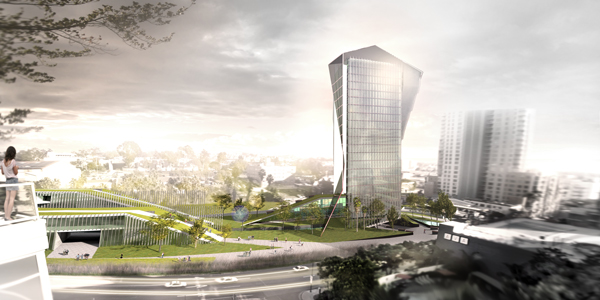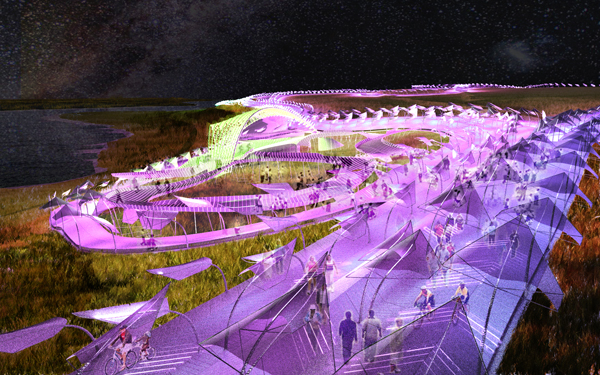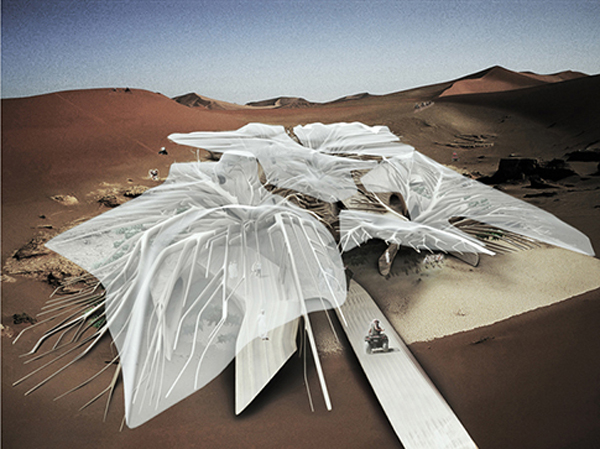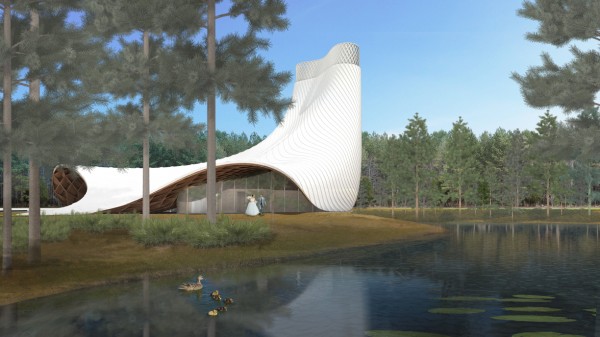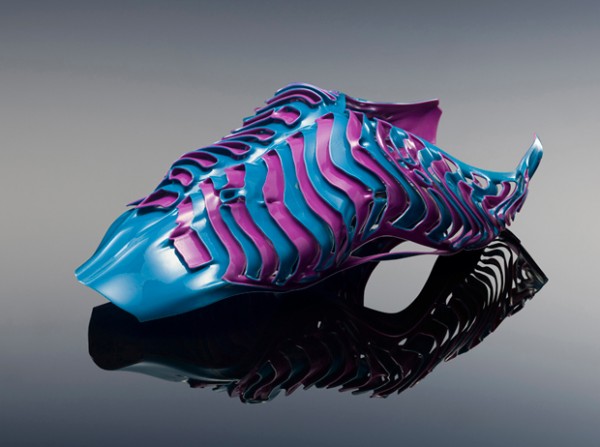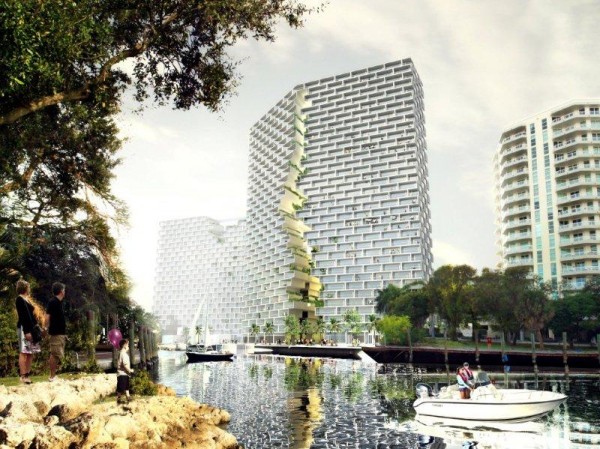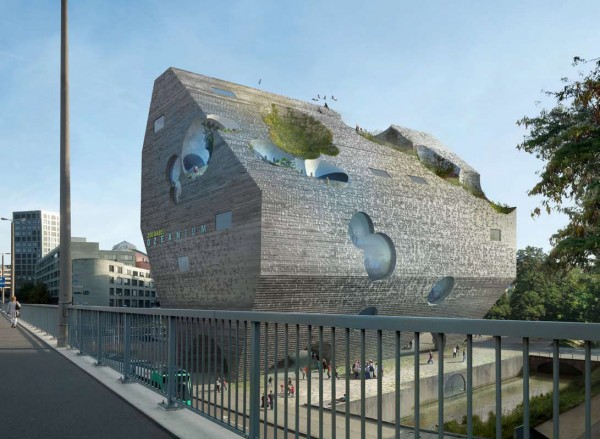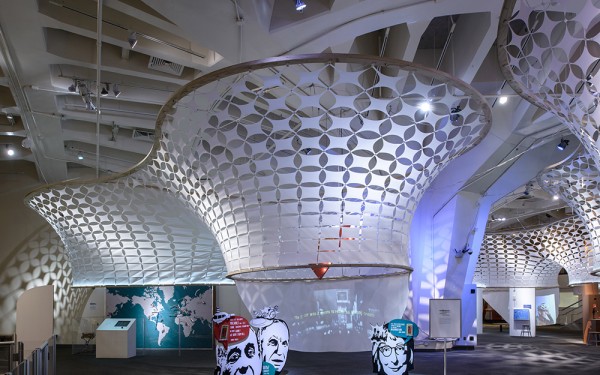Urban Roots is a project designed by Francisco Nunez and Kyle Duvernay to facilitate water access and management by means of biomimetic solutions congruent with architectural design and technology. By carefully analyzing a region in which water is not a local resource, we took on the challenge of designing a new water management headquarters for Downtown San Diego which will implement bio-inspired technologies such as dew harvesting facades, water transfer by capillary action methods and clean water filtration and storage innovations. Read the rest of this entry »
Urban Roots is a Building that Facilitates Water Access through Biomimetic Solutions
Contouring Climatic Porosity
The project by Nash Waters was initiated by looking at the geometry and climatic response of natural systems to build formal and operative logics. The natural ladscape was studied in terms of topography, climate, and material conditions, both analytically through their microclimates and expressively in a response to their horizons.
By studying the biological conditions of foliose lichen, the project was able to utilize various characteristics in order to become a performative structure that is integrated into the landscape. The openings vary in size and thickness on each directional side, optimizing conditions for natural lighting, ventilation, and solar heat gain. Read the rest of this entry »
Piezoscape: Innovative Landscape Converts Mechanical Movement into Electricity
This design for the Fresh Kills landscape by Barker Freeman Design Office engages visitors and the environment into generating energy using piezoelectricity, which is the conversion of mechanical movement into electricity. Energy from wind, sound vibration, and human movement can collectively be harvested from the movement of natural piezoelectric materials embedded in walkable surfaces and bendable wind-capturing stalks and streamers. Systems of piezoelectric components are combined to create a series of spaces, including walking trails, a “playscape,” and an amphitheater that support a range of activity for the Park as a destination for large-scale events as well as for more individual recreational activities. Read the rest of this entry »
Cellular Housing as an Urban Organism
The project designed by Olga Kovrikova, Asa Darmatriaji, and Timothee Raison continues to explore the notion of housing as a cellular component of an urban organism. Our project is a masterplan that is being informed with the landscape previously scanned and analyzed by swarming robots in order to be able to classify certain geological conditions that would lead to produce the network structures on site.
The project is being developed through a layered multi-agent system that is inspired by nature—in our case, desert-dune field pattern formation, desert erosion processes, which are proliferating continuous spaces that have striated, contoured, cavernous surface aesthetics. The scanning robots are developed to avoid obstacles—which can be elements such as high rock formations—and trace geological formations. By applying this scanning technique we are able to generate the height map and geological consistency of the scanned area. Elements such as sand, clay and rock are maps on site and are informing the robots for the next stages of the process—settling the buildings on the site, excavating and printing. Read the rest of this entry »
Brooks + Scarpa with KZF Design proposal for the new Interfaith Chapel at the University of North Florida
Brooks + Scarpa and KZF Design have released their proposal for the new Interfaith Chapel at the University of North Florida in Jacksonville, FL. The proposed 7000 square foot Interfaith Chapel is designed to be a special place where students and others can slow down their lives, re-focus on their spiritual needs and reflect. At the same time, the Chapel will support a variety of diverse religious services, student ceremonies, weddings, other intimate events, lectures, meditative practices and musical performances.
The informal shape of the building footprint symbolizes an allegorical figure, such as Justice, Faith, Hope, Charity, Prudence and Fortitude. The buildings form draws upon references of flowing formal gowns used in weddings and other ceremonial rituals. The top of the building culminates with a large skylight that is shaded by a wooden lattice spire whose form is derived from the symbol of infinity. This combination of flowing natural and cosmic elements results in a unique, formal building while providing a warm interior with soft filtered and reflected light. It inspires an indelible wonder; a dreamlike state of mind that engages the user, heightens their sense of awareness, and brings a deeper understanding to their experience.
The building is organized with a variety of features that reinforce a sense of spirituality and self-reflection, and embrace the local natural environment as well as the macro, cosmological world. Viewed from the center of the sanctuary, a window has been placed high above the ground, facing directly north at 30 degrees above the horizontal. This window is aligned with and provides a direct nighttime view of the Polaris.
The Polaris, or North Star, is a historically important navigational and otherworldly star. Because of its position in the sky, no matter where you are in the Northern Hemisphere, if you face north you are facing toward Polaris. This direct connection from the sanctuary’s interior to an important cosmic symbol encourages the viewer to reflect and forge a deeper and more meaningful understanding of the fundamental, yet delicate relationships that exist between themselves, our collective cultures, the natural world and its vital resources.
The proposed design has other windows and openings strategically placed around the building to allow for views and visual connections to adjacent lake, nearby woods, and other important natural and cosmic features. Some windows are aligned with the winter and summer solstices to allow for the penetration of unique qualities of natural light that occur only during sunrise and sunset of this special moment. Other openings view the lake, garden and provide a welcoming arrival to the chapel. All of these features allow the opportunity for users to co-mingle with special moments of natural phenomena that connect to and honor the role of faith and spirituality. Read the rest of this entry »
Leviathan Sea Monster for the Pompidou Collection
The Leviathan as an ancient sea monster is mentioned six times in the Book of Job where it is described in detail. Among Job’s portrayal of Hell’s gatekeeper are numerous material depictions manifesting the creature’s physical traits which allow him to move speedily at sea despite its heavy build. His back has rows of shields tightly sealed together; Each is so close to the next that no air can pass between them; They are joined fast to one another; they cling together and cannot be parted; The folds of Leviathan’s flesh are tightly joined; they are firm and immovable; His chest is hard as a rock, ‘hard as a lower millstone’ (Book of Job). This underwater wriggling serpent is here re-imagined as armor for the human torso, inspired by the Leviathan’s anatomy and physiology. Composed of a thin stiff shell, cuts are introduced into the surface to allow for the flexibility required for movement and stretching. This body suit is designed as a single continuous surface with thin slots printed in two materials. Each slot is double-sided such that soft materials make up its internal composition providing comfort, while a stiffer material is deposited externally to provide for a protective outer shell.
Design: Neri Oxman in collaboration with W. Craig Carter (MIT) and Joe Hicklin (The Mathworks)
Photos: Yoram Reshef Read the rest of this entry »
New Center for Christian Culture in Kyoto
In 2012, Doshisha University held a competition to build a new chapel and Center for Christian Culture sited upon adjacent sites on their Kyoto campus.
Architects BAKOKO, in collaboration with engineers Structured Environment, proposed to connect the two new facilities with a bridging roof. The notion of continuity is extruded within the cores of this figure-eight formation, to house two sanctuaries devoted to religious worship and culture.
It is a building where structure, form, and function are moulded into a singular totality. Our intention is not to draw attention to the form of the building, but rather, to merge floor, walls, and roof into an immersive experience prioritizing personal reflection and human interaction within the central sanctums.
At the point where the loops merge, the roof arches over a campus thoroughfare, linking two new buildings dedicated to worship and parochial classes, gatherings, and exhibitions. The green roof reduces rainwater runoff and also helps to offset the loss of plants and trees which previously inhabited these greenfield sites. Read the rest of this entry »
BIG Transforms Ft. Lauderdale’s Waterfront into a Vibrant Urban Space
BIG – Bjarke Ingels Group and Cymbal Development transform a portion of Fort Lauderdale’s New River front into a vibrant addition for the local community and future residents of the city.
The mixed-use development, Marina Lofts, in downtown Fort Lauderdale seeks to infuse a currently run-down stretch along the New River with a thriving pedestrian friendly public space thereby attracting new residents into its development. Totaling 1,000 rental apartments, 10,000 sq ft of restaurants and 25,000 sq ft of retail, the mixed-use development is broken into three phases. The Florida-based developer, Asi Cymbal, expects the project to have a positive long-term economic benefit to the city and local community of Fort Lauderdale.
“Our intent here is to create a world class project that will serve as a model for architecture, creativity, and energy along the most prime stretch of waterfront in Downtown Fort Lauderdale,” says Asi Cymbal, owner of Cymbal Development.
Situated in an industrial gap in Fort Lauderdale’s Riverwalk park, Marina Lofts stitches together the final arm of the currently fragmented public space along the New River. BIG’s design frames the space with a generous public promenade bounded towards south by a 3-phase series of residential towers, creating public life along the riverfront while maintaining the existing marine activities of Fort Lauderdale. The two initial housing towers are treated as one continuous building “breaking” at the center to form an opening which allows maximum pedestrian activity to flow between the buildings and extends the city life out to the waterfront. Read the rest of this entry »
Ozeanium: Basel Aquarium
Proposal by HHF and Burckhardt + Partner for the new Basel Aquarium. Zoo Basel is embedded in the city and used as a park by residents and visitors. The redesigning of the green area Nachtigallenwäldeli and the construction of the new Ozeanium, an ocean aquarium, on the Heuwaage are bringing the zoo and the park area even closer to the city center, to form an attractive living environment and recreational area. The proposed Ozeanium accommodates the scale of the surrounding buildings, such as the Rialto swimming pool, the market hall and the tall buildings on the city ring. The striking, con!dent construction volume is a clear indication of what an attraction this will be, enriching the city in a central location.
The roof and facade are homogenous in terms of the materials and the language of forms: exposed concrete, horizontally graduated by rough boarding and with sediment-like exogenous inclusions. The archaic building is riddled with differently sized openings and recesses, making it possible to ascertain the most important themes from the outside. Some of the spherical indentations in the building volume are planted with vegetation and serve as habitat for birds and small animals. Read the rest of this entry »
Floating Cloud Installation for Various Artists in NYC
SOFTlab and The Living produced the exhibition design for ReGeneration at the New York Hall of science. ReGeneration includes ten installations produced by various artists that explore immigration, urbanization, and sustainability through art, science and technology. Our brief was for the exhibition design to not only be a platform for the other installations, but to also be an installation in and of itself making it one of the ten artist installations.
The New York Hall of Science is located in Queens, NYC, the most ethnically diverse county in the United States. The exhibition framed the idea of sustainability as a system that is exothermic. That New York City is an exothermic system that thrives on the infusion of energy through immigration and generates energy through ideas and knowledge. We looked at this idea at various scales: global, national, city, borough, etc. We found that it is not simply the infusion of various groups or energies into a system, but the mixing and tangencies of these energies and mixing that produces a “melting pot” of ideas. It is through this mixing and turbulence of many ideas that a larger community forms—one that can be seen as a larger whole while still retaining the ability to show a “finer grain,” much like the interconnected loops of an ecosystem, or like many local “weathers” within a regional or global weather system. We treated the overall exhibition as an opportunity for the mixing of various artists responding to the community in many ways, in hopes to create a critical mass of tangencies that extend an influence outside of the museum into the larger community.
We inverted the typical exhibition design of white walls and subdivisions and created a floating cloud that not only marked the zones of each artist installation but connected them under a common roof. More specifically, the “cloud” consists of multiple interconnected “weathers” at the multiple scales of the artwork, the community, Queens, New York City, the country, and the world. While each “weather” has its own features and identity, they have many overlapping, “common” themes, and there are many threads that tie them together into one “common” ecosystem. In other words, the cloud is a kind of weather for the Regeneration exhibition–but rather than a single weather, it is really several common weathers. Read the rest of this entry »

